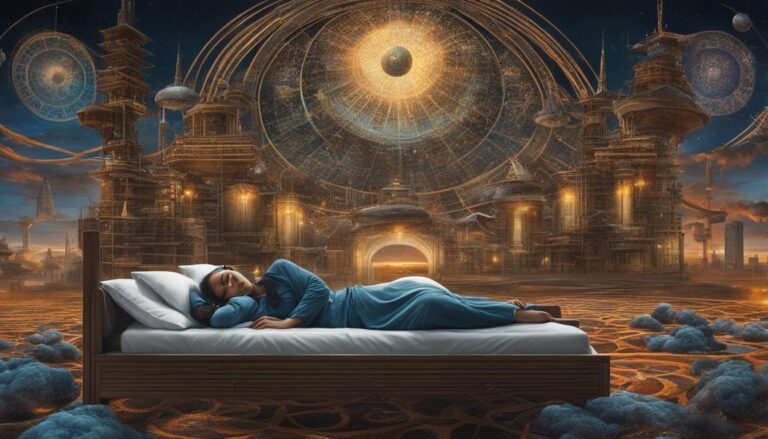Comparing Dream Symbols Across Cultures
Dreams have long fascinated and intrigued people across the world. They offer a glimpse into our subconscious mind, providing a unique lens through which we can explore our deepest desires, fears, and hopes. Interestingly, dreams and their symbols are not limited to a specific culture or region – they are universal experiences shared by people from all walks of life.
When we delve into the realm of dream interpretation, we discover that dream symbols can vary across different cultures. While some symbols may hold similar meanings, others can be culturally specific, influenced by the beliefs, values, and experiences of a particular society.
For instance, a study conducted with Chinese, German, and Canadian students found that certain dream themes were prevalent in all three cultures. These included symbols such as schools, being chased, falling, and sexual experiences. Despite subtle variations, the overlap in dream symbols indicates a shared undercurrent of human experience and emotion that transcends cultural boundaries.
Understanding the cultural significance of dream symbols is vital in unraveling their deeper meanings. Different cultures attribute diverse interpretations to these symbols, shaping their understanding of dreams and their role in daily life. In some societies, dreams are regarded as portals to the spiritual world or valuable sources of future information, while in others, dreams are seen as reflections of one’s innermost thoughts and desires.
As we explore the fascinating world of dream interpretation, we gain insights into the remarkable ways in which dreams and their symbols resonate across cultures. Each culture brings its unique perspective and understanding of dreams, enriching our collective understanding of the human psyche. So, let us embark on this journey of discovery, as we delve deeper into the world of dream symbols and their cultural significance.
Key Takeaways:
- Dream symbols in different cultures share common themes such as schools, being chased, falling, and sexual experiences.
- Cultural beliefs and values shape the interpretation and significance of dream symbols.
- Dreams can be viewed as windows into the spiritual world or reflections of one’s inner thoughts and desires.
- Shared dream symbols across cultures highlight the universal aspects of human experience and emotion.
- Exploring dream symbols in different cultures enriches our understanding of the human psyche.
Cultural Significance of Dream Symbols

In the realm of dreams, cultural influences play a significant role in shaping the way people interpret and attribute meaning to their dreams. Dreams are seen differently across different cultures, with varying beliefs about their significance and symbolism. While some cultures dismiss dreams as unreal and irrelevant, others consider them valuable sources of information about the future, the spiritual world, or oneself.
Dream symbols hold diverse cultural interpretations. For instance, the Parintintin of South America believe that dreaming of someone erotically indicates that person desires the dreamer, while the Azande of Central Africa perceive bad dreams as signs of being bewitched. Shamans in certain South American cultures even use their dreams as a means of exercising their power, considering them as a domain for real action.
These cultural variations highlight the rich and diverse tapestry of beliefs surrounding dreams. Whether dreams are seen as spaces for communication with supernatural beings or as channels to access different levels of reality, they offer unique insights into the human experience and the ways in which culture shapes our understanding of the world.
Dreams as Predictions of the Future
In many cultures, dreams have long been believed to offer glimpses into the future. Whether interpreted literally or through symbolic references, dreams are seen as a source of knowledge that can provide insight into what lies ahead. Various systems and rules have been developed to interpret dreams as predictions, lending an air of mysticism and intrigue to this age-old practice.
Emotional dreams, such as those involving violence or sexuality, often carry positive interpretations in the realm of predictive dreaming. They are believed to foretell good luck or success in hunting. Similarly, dreams depicting the death of someone may be interpreted as granting that person a longer life. These interpretations serve to alleviate anxieties caused by disturbing dreams and offer comfort to dreamers by linking their nighttime experiences to the continuation or transformation of their thoughts before falling asleep.
Conventional dream interpretation across cultures recognizes that dreams may contain valuable insights into the future. Through this lens, dreams become a realm of potential foreknowledge, providing a unique perspective on what lies ahead. While the accuracy of these predictions remains subjective and open to interpretation, the belief in dreams as predictive tools continues to hold a significant place in many cultural practices and beliefs.
Social and Therapeutic Aspects of Dreaming

In addition to their cultural significance, dreams also play important roles in the social and therapeutic aspects of human life. In many cultures, sharing dreams is considered a significant social disclosure. It can serve as a means of connecting with others, deepening interpersonal relationships, and fostering a sense of community. Dream sharing often follows social rules and etiquette, with appropriate settings and contexts for discussing and interpreting dreams.
Furthermore, dreams have long been recognized for their therapeutic potential. Various cultures have developed rituals, practices, and techniques for using dreams as a tool for healing and personal growth. Dream interpretation, in particular, is a common therapeutic approach. By exploring the symbols and meanings embedded in dreams, individuals can gain insights into their unconscious desires, fears, and unresolved conflicts.
Dreams can provide a valuable window into the unconscious mind, offering a unique opportunity for self-reflection and self-discovery.
Moreover, dreams can serve as a medium for emotional processing. They allow individuals to experience and process intense emotions, fears, and traumas in a safe and controlled environment. Through dreamwork, individuals can confront and work through unresolved emotional issues, leading to greater emotional well-being and psychological growth.
The Therapeutic Use of Dreams in Practice
Several therapeutic techniques have emerged that specifically focus on utilizing dreams for healing purposes. One such technique is dream journaling, where individuals write down and reflect on their dreams regularly. This practice helps individuals to better remember their dreams, identify recurring patterns or symbols, and gain a deeper understanding of their psychological state.
Another approach is dream visualization, where individuals actively engage with their dreams through guided imagery or visualization exercises. By entering the dream space in a waking state, individuals can explore their dreams in a more conscious and deliberate manner, uncovering hidden meanings and insights.
Overall, the social and therapeutic aspects of dreaming highlight the profound impact that dreams can have on individuals and communities. Whether it is through social bonding, personal growth, or emotional healing, dreams continue to play a significant role in the human experience.
Dream Space and the Space of Waking Life

Dreams transport us to a distinct realm, a subjective space that exists separately from the space we inhabit when we are awake. This dream space is a mysterious and complex realm that holds its own significance and symbolism. In this section, we will explore the relationship between dream space and the space of waking life, and how different cultures perceive this connection.
While dreams are often seen as separate from waking reality, many cultures acknowledge the existence of both spaces as real in their own right. For some, dreams provide a glimpse into an alternate level of reality or serve as an entry point to a spiritual realm. The Parintintin people of South America, for example, believe that dreaming of someone indicates that the person is thinking of the dreamer with desire.
However, despite recognizing the reality of dream space, all cultures make a clear distinction between dreams and waking life. Dreams are not regarded as simply an extension of one’s thoughts before sleep, but rather as a unique and separate experience. They can be seen as channels of communication or even real acts in certain cultural contexts.
The Subjective Experience of Dreams
The subjective experience of dreams is a fascinating aspect of dreaming that varies across cultures. Our dreams are deeply personal and can evoke a wide range of emotions, sensations, and perceptions. Dreams can elicit feelings of fear, joy, or even confusion. They can transport us to familiar or unfamiliar places, involve people we know or complete strangers, and present us with scenarios that may seem ordinary or fantastical.
As we delve into the subjective experience of dreams, we begin to uncover the intricacies of our own subconscious minds. Dreams can provide insight into our deepest desires, fears, and unresolved conflicts. They can offer a glimpse into our inner selves and serve as a tool for self-exploration and understanding.
“Dreams are the touchstones of our character.” – Henry David Thoreau
Whether dreams are viewed as glimpses into alternate realities, channels of communication, or windows into our own psyche, the subjective experience of dreams remains a captivating and enigmatic aspect of the human experience.
Cultural Beliefs About Dreaming
In exploring the realm of dreams, it becomes evident that cultural beliefs about dreaming are as diverse as the dreams themselves. Across different cultures, dreams are viewed through various lenses, offering unique insights into the nature of dreaming and its significance. These cultural beliefs shape the way dreams are interpreted, shared, and used for therapeutic purposes.
Some cultures consider dreams to be experiences of the soul that wanders during sleep. In this view, dreams are seen as glimpses into a realm beyond the physical, where the subconscious mind roams freely, exploring hidden desires, fears, and aspirations. On the other hand, some cultures perceive dreams as a continuation of the thought processes before sleep, reflecting the inner workings of the mind.
Dreams are often intertwined with cultural beliefs about the future. In many societies, dreams are regarded as omens or prophetic messages that provide glimpses into what lies ahead. Symbols and metaphors in dreams are deciphered to unravel hidden meanings and uncover insights into upcoming events. The interpretation of dreams can vary greatly from one culture to another, reflecting the unique perspectives and traditions of each society.
Not only do cultural beliefs shape the interpretation of dreams, but they also influence how dreams are shared and used for therapeutic purposes. Dream sharing is often governed by social rules, emphasizing the importance of the context in which dreams are shared. In some cultures, dreams are regarded as significant social disclosures, serving as a means of strengthening bonds and fostering a sense of community. Furthermore, various rituals and practices are employed in different cultures to utilize dreams for healing and personal growth.







